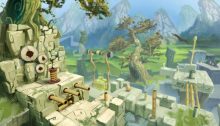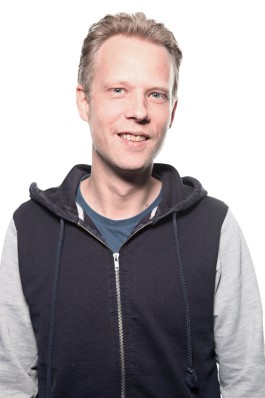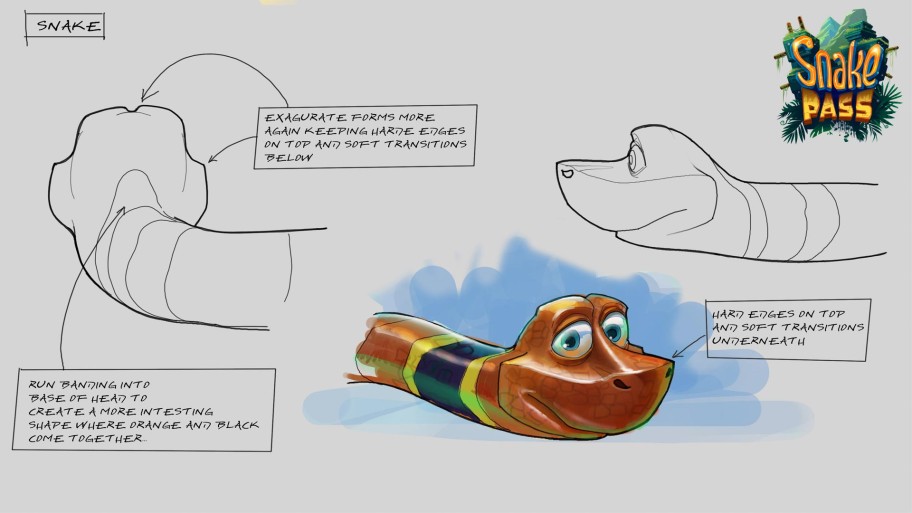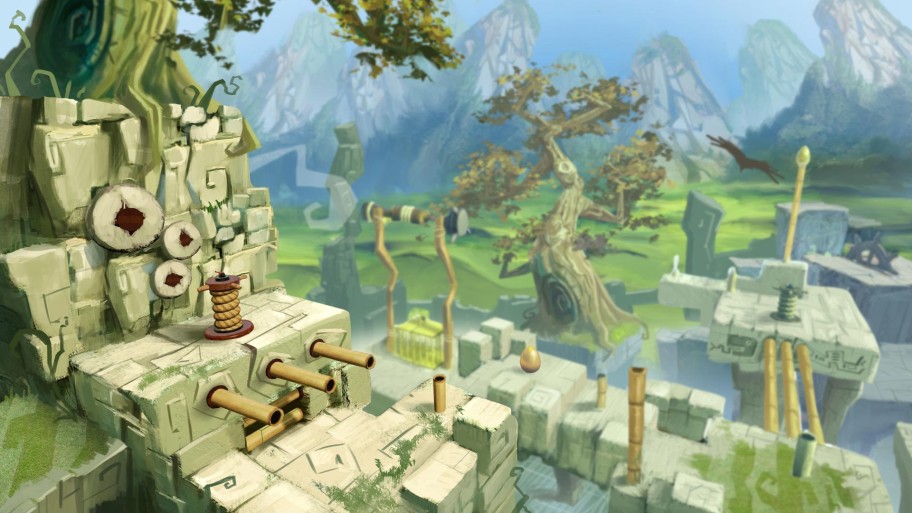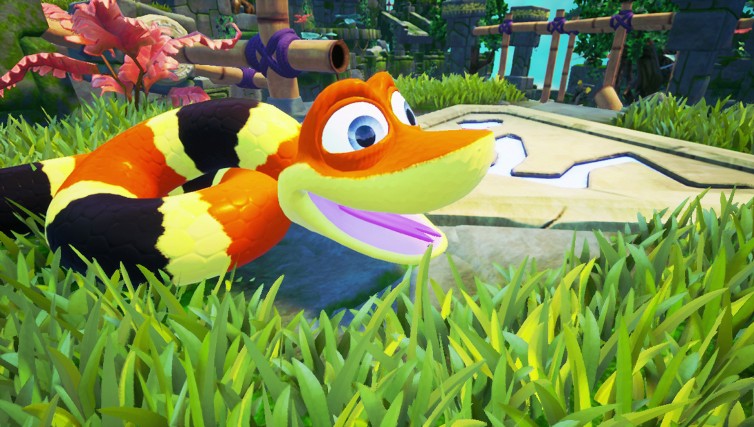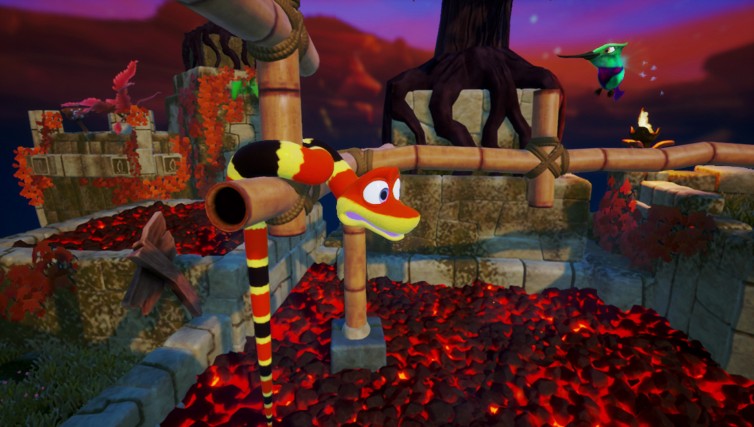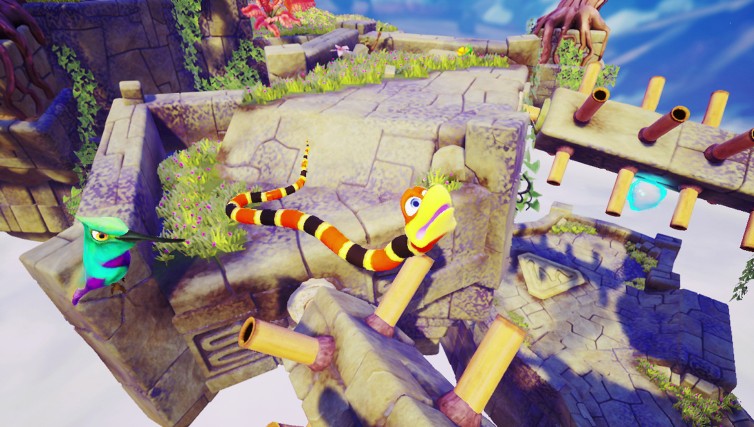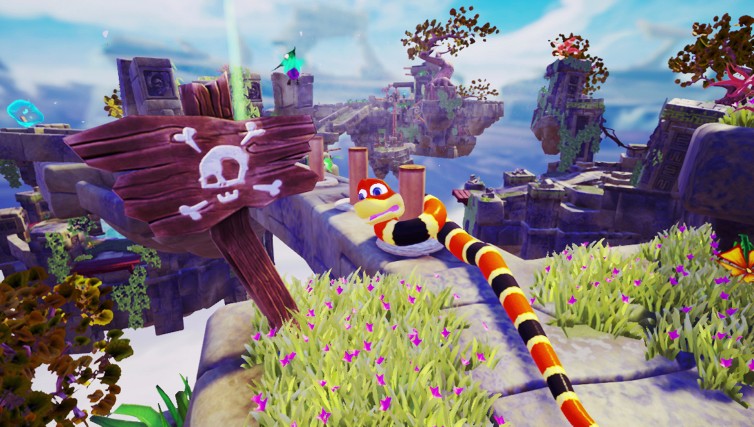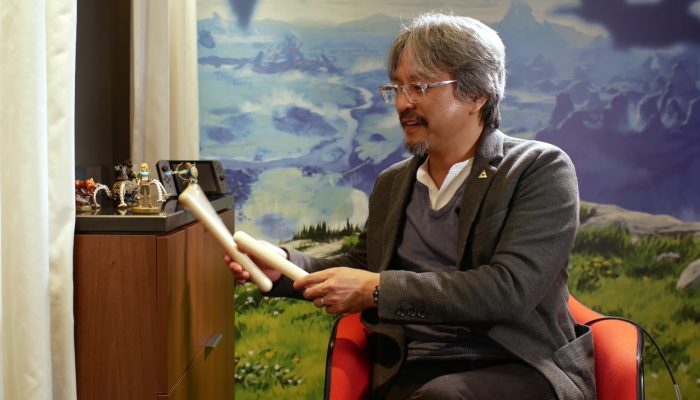 “There’s so much potential still left in the idea that I think everybody who worked on it would love to realise that potential in either the form of DLC or maybe a sequel.”
“There’s so much potential still left in the idea that I think everybody who worked on it would love to realise that potential in either the form of DLC or maybe a sequel.”
☆ NintendObs Weekly – Monday, April 10, 2017 – Sunday, April 16, 2017.
The Making Of Snake Pass
Seb Liese, creator of Snake Pass on Nintendo Switch, tells us how he came up with the wildly original platform game.
10/04/2017
Snake Pass by Sumo Digital is a wildly original platform game for Nintendo Switch in which you have to “think like a snake” to slither your way to victory. It’s available on Nintendo eShop right now and is already proving popular with Nintendo Switch owners. At this year’s EGX Rezzed in London, we caught up with original creator Seb Liese to find out how he came up with this new type of platform game.
Nintendo UK: Where did the idea for Snake Pass come from?
Seb Liese: When Sumo Digital gave me a small period of time to try to learn Unreal Engine, one of the things I tried to make early on was a rope that would move when a player touches it. As I was creating this rope, I pressed the play button and had forgotten to attach it to the ceiling. When I saw it fall on the floor in this really nice smooth shape that collided with itself I thought back to my background as a biology teacher, when I had two pet snakes, and I instantly thought ‘hey, this could be a snake!’
Right around that time we had an internal game jam at Sumo. I showed it to a colleague before the game jam and when he saw it, he was like ‘dude, I’ve never seen anything like this, you’ve got to put this in a game jam and you might actually win’. We brought it to EGX Rezzed for the first time last year, really as a test to see if there was an audience. The reception to the game was just amazing, so the day after when we came back to the office the director came in and he was like ‘We’re going into full production, you’re getting a full team, you get a year, let’s make a real game out of this!’
NUK: How has the game design changed from that original demo to now?
SL: When I presented the initial idea we were planning to make Noodle grow as you collect things, but as we started experimenting we realised that the length that he is now is the optimum length. It’s currently 35 spheres long and we’ve experimented with everything between one sphere, which is basically a head and a tail, up to maybe 70 spheres just to find when the climbing feels best. We realised that as soon as you’re much shorter you can’t climb anymore, so we almost had to build a separate game for when you’re short, when you can’t climb.
We didn’t have the time and the budget, initially, to realise that in a good way so it would not have felt good enough to include. And the same thing applies when you make him longer; even five spheres more, the element of gravity pulling your tail becomes more and more present so it just becomes a nuisance; this long thing you’re constantly dragging around with you.
NUK: How did you settle on the cartoony aesthetic for Snake Pass?
SL: Initially, because I have this biology background, I based Noodle on one of my pet snakes, so it looked realistic. The game literally started with a white plain with a snake on it. So when I had the realistic snake I was leaning towards a realistic type of game where you kill stuff, strangle stuff; a stealth approach in a natural environment. But when we started showing demos to people they were genuinely creeped out. People have an inherent fear of snakes and when we realised that stopped them from picking up the game, we decided ‘this snake needs to be as cute and approachable as possible’. I always wanted to make a Rare type of game, so it was a perfect fit in hindsight.
NUK: Many people have mentioned that Snake Pass looks like a Rare game, but it sounds like one too since you hired Donkey Kong Country composer David Wise to create the soundtrack. Did that come about after the shift in art direction?
SL: Actually, no. I’ve been a fan of David Wise for as long as I can remember. When I was a kid, playing Donkey Kong Country, I would literally go into a level, put the controller down and listen to the theme tune over and over. So, pretty much immediately after I won the game jam I jokingly said ‘I want David Wise to do the music’. I kept saying it as a joke and then one day our audio producer tapped me on the shoulder and he said ‘I’ve got a surprise for you. We actually approached David Wise and showed him footage of the game and he absolutely loves it and he would love to do the music for it’. It started off as a joke and became like a dream come true!
NUK: How difficult was it to come up with the controls for Noodle when there’s no precedent for how a game like this should work?
SL: It feels good to control the snake on the edge of the analogue stick by making this rotation movement. It’s all about translating the feeling of the controller to what happens on the screen. Essentially when you boil it down to the essence, that is what a video game is. Traditionally, in game design, I think 99% of designers will start off with some kind of mouse & keyboard control for prototyping, but I’m a console gamer, I always design using controllers. So from the get-go I never even had a control scheme for PC. It was always focused around the controller.
NUK: There’s something great about Snake Pass’s controls that introduces a learning curve for the player. It’s a challenge to learn the controls, get better at them and perfect Noodle’s movements…
SL: Yes, mastering Noodle is a learning process and it’s a skill that you acquire. So it requires training. Anything that you get better at, it doesn’t even need to be video gaming, is satisfying and triggers a certain area in your brain that makes it pleasant to do. So, we knew the controls were difficult but we also knew it wasn’t impossible to control him from the start and it is that self-improvement that makes the game so appealing.
NUK: The challenge of the game is communicated so well in Noodle’s facial expressions, which are really amusing to see. Where did they come from?
SL: The aspect of gameplay affecting his facial expression is purely based on the idea of us watching people playing the game and trying to make Noodle look the way players are feeling at that point. A lot of the time when you use the grip ability you are in a situation where you will, as the player, make funny facial expressions. So that’s the face he makes too! We constantly check how much of his body is in contact with things and we assume that the less things you are touching, the more worried he is about his own well-being. So, his facial expression is largely based on how much of his body is currently in contact with something and that sort of worked out pretty much to mimic what the player is feeling.
NUK: What can fans of Snake Pass expect next from Noodle?
SL: As we were creating Snake Pass we constantly had ideas that we weren’t able to implement. There’s so much potential still left in the idea that I think everybody who worked on it would love to realise that potential in either the form of DLC or maybe a sequel.
Especially for DLC. When you make DLC, you’re going to assume that everyone who will buy it has fully finished and enjoyed the rest of the game. So we don’t have to worry any more about difficulty; we know that everyone who is playing the DLC has mastered Noodle. And there’s so many crazy things that Noodle could still do, if only we were sure that people have the skills. So if and when we go DLC, you’ll get some really cool things that we know he can do.
Snake Pass is out now on Nintendo Switch, available from Nintendo eShop! For more information follow the official Snake Pass Twitter account here.
— Nintendo UK News
Source: Nintendo UK.
At NintendObserver, the comments are on Discord.
Click on Community to learn more. 🙂
…
…Wanna play? Buy a Switch.
And if you’ve already got yours, click on Snake Pass for everything you need to know about the game. 😀
